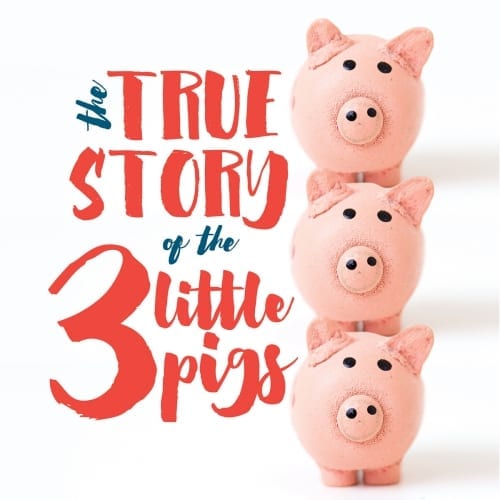
Show closes December 29, 2017.
SALT LAKE CITY — If you have been or had a kid since 1989, you’re probably familiar with Jon Scieszka and Lane Smith’s children’s book The True Story of the 3 Little Pigs, which retells the classic story from the wolf’s perspective. If you’re among the uninitiated, however, you might think of this musical adaptation by Paul Gilvary, Robert Kauzlaric, and William Rush like this: It’s a little bit Wicked, in its attempts to make moral ambiguities palatable enough for a younger crowd, and a little bit The Mystery of Edwin Drood, for its employment of both the show-within-a-show conceit and a specific type of audience participation. Overall, I have a lot of praise for the creative team’s conceptual approach to the material, if not for all their choices (particularly the music). Nevertheless, the cast and production staff at Salt Lake Acting Company, led by director, music director, and choreographer Penelope Caywood, have made this adaptation look better than it is. It’s silly, it’s filled with pig puns, and my kids had a great time.
Since the source material alone could not fill out the show’s 50-minute run time, the story from the book becomes the sworn testimony of Alexander T. Wolf (played by Derek Gregerson) as he stands trial in the Court of Pigsylvania for the murder of two of the three little pigs. As the name Pigsylvania implies, the rest of the characters are all pigs, making the legal proceedings, presided over by the Honorable Prudence (Betsy West), about as impartial as one would expect. In a nod to the book’s newspaper motif, cub reporter Lillian Magill (Ali Bennett) is on the scene to cover the developing story while Julia (Becky Jeanne), the prosecutor, pushes a traditional version of events on the audience, which serves as the jury.
Julia and the wolf make their cases through musical reenactments of what they say happened with the help of some delightful puppets, designed by Steven Glenn Brown and Linda L. Brown. I particularly liked the wolf’s serpentine arms and the pigs’ 360-degree mouths. Set designer Thomas George and prop designer Janice Jenson have tempered the solemnity of the courtroom’s floor-to-ceiling wood paneling with pig touches—such as pink highlights in the wood, a flag with pigs instead of stars, and carved pigs in profile above the judge’s seat. I especially admired the seal of the state of Pigsylvania set into the floor. However, with such attention to detail on display, I admit I wondered at the absence of any piggy-ness in the bunting on either side of the dais.
The performances all impressed me. In particular, Jeanne, as the prosecutor, displayed a wickedly self-assured aggression beneath an onslaught of ebullient charm. I was also highly amused by Trevor B. Dean’s many transformations. Dean plays the bailiff, two different witnesses, and the surviving pig, each with distinct vocal characteristics and physicality. Throughout, the whole cast maintained an appropriately exaggerated tone and sang the score well.
However, despite the strong singing, the show’s greatest weakness is the music. Often, the best art finds depth in simplicity. This is true even when (perhaps especially when) something is intended for children. To be clear, I wasn’t exactly expecting life-changing profundity, but I would have settled for clever. Unfortunately, the simplicity of Gilvary and Rush’s score isn’t the good kind. For one thing, it’s full of slant rhymes—which, I hasten to add, I’m not opposed to in principle. English is not easy to rhyme and slant can make for unexpected and refreshing use of language in the right hands. That isn’t the case here. Rather, the non-sequitur half-rhymes feel more like a lack of effort. For example, rhyming “piggy world” with “watch our tails curl” comes off as lazy both for the rhyme and because the meter felt so awkwardly shoehorned into the music.
Nevertheless, I still recommend this show, especially if you’re looking for something to take your kids to this month in which the names “Scrooge” and “Herdman” are nowhere to be seen. Moreover, in addition to the strength of the production itself, SLAC deserves a lot of credit for taking the “children” in children’s theatre seriously. Their Title I Arts Education Program will allow 1,700 kids from local schools to see this show at no cost—many of which will be experiencing live theatre for the first time. It’s sure to be a good experience for them.
While it’s true I was less impressed by the music, as the play makes a point of saying more than once, there are at least two sides to every story. As a case in point, my nine-year-old daughter liked The True Story of the 3 Little Pigs so much that she demanded I let her read this review before submitting it so she could make sure I wrote “only good things.” She didn’t follow through on that, but it does give you an idea of what she considers the “true” story to be.




